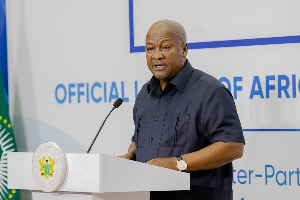Accra, May 3, GNA - The Bank of Ghana on Thursday outdoored the Ghana Cedi notes and coins and the Ghana Pesewa coins in Accra, stressing that it underpins the stable economic regime the country has been enjoying.
Dr. Paul Acquah, Governor of the Bank of Ghana, described the unveiling of the new currency notes and coins as "a critical landmark" in the Central Bank's public education programme of the re-denomination scheduled to commence on July 1, 2007.
He dubbed this aspect of the education as "Know Your Notes and Coins and Security Features".
"It would be pursued through visual presentations on TV, posters as well as direct community contacts to allow for easier identification of the Ghana Cedi coins and notes and the Ghana pesewa coins." Unveiling the new currency, Dr. Acquah said they are designed to pay tribute to some key personalities for their contribution to the social, political and economic development of the country.
They also reflect the historical significance of some of the national monuments and cultural values of the nation's development. The design of the notes involved the selection of dominant colours for each note with prominent national monuments and concepts for the reverse.
He said that they all incorporated very robust security features to allow for easy and safe recognition and transactions. Significantly, the front (obverse) sides of the new notes have one portrait comprising the Big Six who championed Ghana's political independence.
The 50 Ghana Cedi (GH=A2 50) depicts the Christianborg Castle, the seat of government at the reverse while the 20 Ghana Cedi (GH=A2 20) shows the Supreme Court Buildings representing the rule of law at the reverse. The two together capture the importance of good governance in Ghana.
The 10 Ghana Cedi (GH=A2 10) shows the Headquarters of the Bank of Ghana at the reverse, which acknowledges the Bank as the sole issuer of currency as well as the significant role of the financial system in the overall development of the economy.
The five Ghana Cedi (GH=A2 5) has the University of Ghana, the nation's premier University at the back, representing the role of education in the social, political and economic development while the one Ghana Cedi (GH=A2 1) has the Akosombo Dam at the back, recognizing its key role in generating electricity over the years for industrial and domestic use, which has been the back-bone of economic activity.
The new coins capture the Ghana Coat of Arms shown at the reverse of all of them. They also capture, among other things, the mineral and agricultural wealth of the country; the continuing link between Ghana and the Commonwealth; the lone star of African Freedom and national aspirations.
The fifty Ghana pesewas (50Gp) has an image of a market woman, symbolizing the significance of women in business and their contribution in building the Ghanaian economy.
The 20 Ghana pesewas coin (Gp20) depicts the cocoa pod which represents the agricultural wealth of our country and economic importance of cocoa over the years, the 10 Ghana pesewas (Gp10) is devoted to a book, which emphasizes the role education plays in a democratic society, while the five Ghana pesewas (Gp5) shows a horn blower, symbolizing the traditional mode of communication in Ghana. The one Ghana pesewa (Gp1) has an image of the Adomi Bridge, indicating the significance of infrastructure and freedom of movement of goods and people in a united Ghana.
Dr. Acquah said the notes had strong safeguards with regard to security and durability including a watermark as an integral part of the notes.
This carries an image of Tetteh Quarshie, the man who first brought cocoa seed into Ghana in 1879 from Fernando Po, off the West African coast. It also has the image of Tetteh Quarshie and the cocoa pod appears in subtle areas of light shades when held up to the light. It has a see-through feature, which allows the denomination of the bank note to be seen clearly when held up to light. Another security feature is a latent image, which is not obvious to the observer when viewed normally, but at a 45 degree angle the image of the denomination appears.
Dr Acquah said a security thread can be seen which changes colours from red to green when tilted for the 20 and 50 Ghana Cedis, or shiny silver bars for the one, five and 10 Ghana cedis. A solid line appears containing the text Ghana and the denomination when held up to the light.
"Each denomination is printed in intaglio gold which combines the unique characteristics and the benefits of intaglio printing with a metallic golden coloured ink.
"There is also an iridescent band that has a colour-shifting property which makes the colour appear shiny from one angle and matt from another angle," the Governor said. Dr Acquah said the new currency notes also have a hologram in the 10, 20, and 50 Ghana Cedis which incorporates numerous smaller images in two distinct sets that is "BG" and denomination. 03 May 07
Business News of Thursday, 3 May 2007
Source: GNA


![New IGP, COP Christian Tetteh Yohonu [L] and immediate-past IGP, Dr. Akuffo Dampare New IGP, COP Christian Tetteh Yohonu [L] and immediate-past IGP, Dr. Akuffo Dampare](https://cdn.ghanaweb.com/imagelib/pics/140/14041582.295.jpg)









